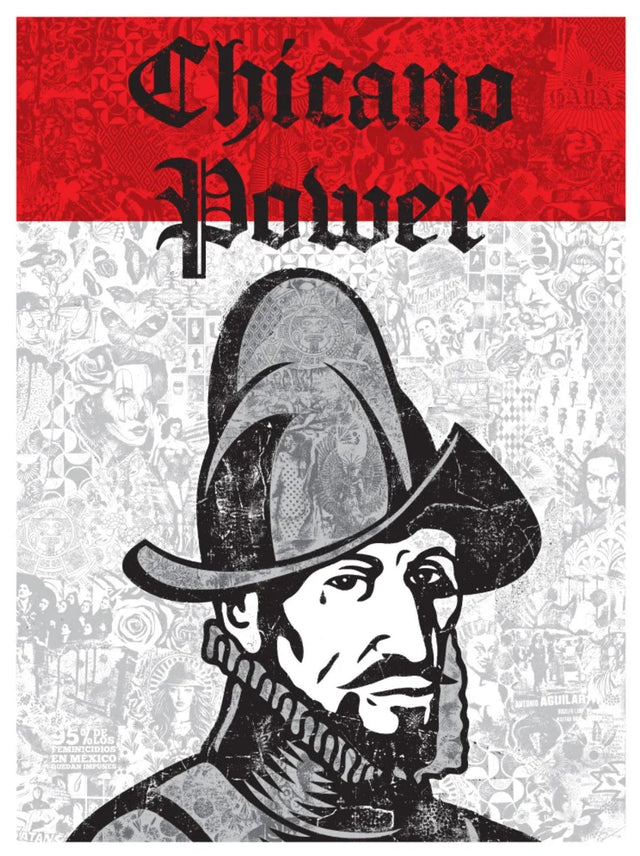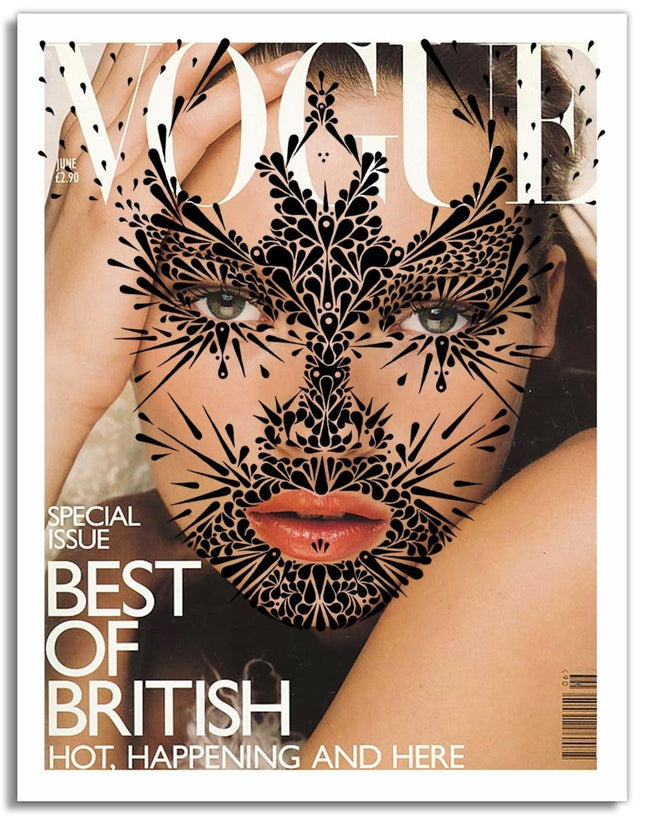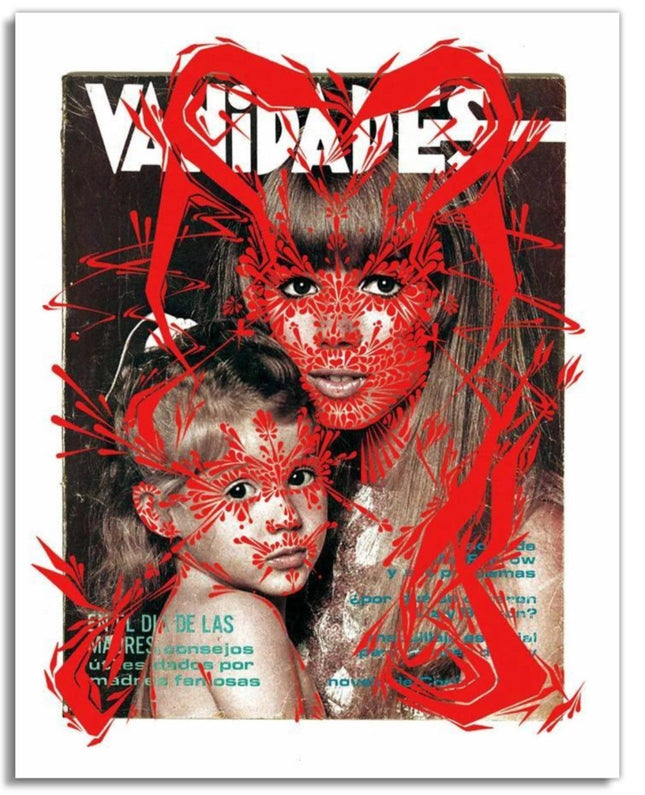
Latin

Stinkfish Vogue Black Silkscreen Print by Stinkfish
Vogue- Black Hand-Pulled Limited Edition Silkscreen Print on Fine Art Paper by Stinkfish Rare Street Art Famous Pop Artwork Artist. 2015 Signed & Numbered Vogue by Stinkfish Screen Print Edition of 60 | Signed by the Artist Size: 18" x 24" City: Bogata, Colombia. The first release was based on a Spanish language magazine Stinkfish had found - the second is based on an English language magazine they had found for him. His lively detailing abstract redefines the glamor and beauty of Kate Moss. Stinkfish and the Evolution of Street Pop Art The Colombian street artist, Stinkfish has carved a unique space for himself in contemporary art. His works, often characterized by vibrant colors and intricate stencils, reflect the dynamic energy of street culture. One of his notable contributions to the art world is a limited edition silkscreen print on fine art paper titled "Vogue," a work that seamlessly blends street art's rawness with pop culture's polished aesthetics. This particular piece from Stinkfish pays homage to the iconography of fashion magazines, explicitly drawing inspiration from a Vogue cover. It's a rare street art piece that elevates the familiar image of a fashion model to a work of famous pop artwork. Created in 2015, this signed and numbered screen print is part of an exclusive series, with only 60 editions made available, each measuring 18" x 24". The art was conceptualized in Bogota, Colombia, and it represents a significant departure from Stinkfish's often more spontaneously created public murals. The Artistic Process Behind Stinkfish's "Vogue" The "Vogue" silkscreen print by Stinkfish is particularly notable for its process and backstory. The inception of the artwork is rooted in the discovery of a Spanish-language magazine that caught the artist's eye. Later, a second iteration was based on an English language magazine provided for him, suggesting a narrative that spans cultures and languages. This cross-cultural journey is central to understanding the piece, reflecting the globalized nature of both street art and fashion. The artwork showcases Stinkfish's signature style, with intricate black patterns overlaying the photograph, transforming the image into something more abstract and lively. The patterns vibrate with life, giving the piece a kinetic energy that redefines the glamour and beauty associated with the fashion model, reportedly Kate Moss. Stinkfish's work disrupts the conventional portrayal of fashion figures, infusing them with a rebellious and celebratory spirit. Impact and Significance of "Vogue" in Street Pop Art "Vogue" is a testament to street pop art's transformative power. Stinkfish's approach to the piece—taking a symbol of high culture and reinterpreting it through the lens of street art—challenges perceptions of value and beauty in the art world. By incorporating elements of graffiti artwork, the print becomes a commentary on the permeable boundaries between high and low culture, between the exclusive elite of fashion and the inclusive, democratic nature of street art. The limited edition nature of "Vogue" also speaks to the changing landscape of art collection. Traditionally, street art is ephemeral, often illegal, and created in the public eye. By transferring his work onto fine art paper and limiting its production, Stinkfish bridges the gap between the fleeting nature of street art and the permanence sought by collectors. This rare edition allows for broader access to his work and elevates the status of street art within the fine art market. Stinkfish's "Vogue": A Cultural Intersection Stinkfish's "Vogue" silkscreen print is much more than a collectible piece of art; it is a cultural artifact that embodies the intersection of diverse artistic worlds. It encapsulates the essence of street pop art and graffiti artwork while respecting the polished world of fashion. This print is not merely a representation of a fashion icon but a redefined image that challenges the viewer to see beyond the surface and appreciate street art's underlying vibrancy and complexity. As such, "Vogue" by Stinkfish is a significant contribution to the discourse on the value and place of street art in contemporary culture.
$209.00

Stinkfish Wild Vanity Red Silkscreen Print by Stinkfish
Wild Vanity- Red Hand-Pulled Limited Edition 5-Color Silkscreen Print on Cougar Natural Paper by Stinkfish Rare Street Art Famous Pop Artwork Artist. 2014 Signed & Numbered Wild Vanity by Stinkfish Screen Print Edition of 65 | Signed by the Artist Size: 18" x 22.5" City: Bogata, Colombia. Five color screenprint on Cougar Natural printed at FugScreens Studios, 18″ x 24″. Stinkfish's "Wild Vanity": A Vibrant Fusion in Street Pop Art "Wild Vanity" emerges as an exceptional creation from Stinkfish, an artist renowned for his vivid street pop art and graffiti artwork. This piece represents a striking amalgamation of the artist's signature stencil style with the vibrant color palette that often characterizes his work. Hand-pulled and limited to a series of 65, "Wild Vanity" is a five-color silkscreen print on Cougar Natural paper that showcases Stinkfish's exploration into the vibrancy of human features juxtaposed with the abstract patterns that define his artistic expression. Crafted in 2014 and sized at 18" x 22.5", "Wild Vanity" was brought to life at FugScreens Studios, known for its exceptional screenprinting work. The artist's choice of Cougar Natural paper—a high-quality, uncoated stock—serves as the perfect canvas for the print, ensuring that the colors remain vivid and the details sharp. Each hand-pulled print is signed and numbered by Stinkfish, offering a tangible connection to the artist's hand and vision. The Artistic Language of Stinkfish in "Wild Vanity" The artistic language Stinkfish employs in "Wild Vanity" is bold and subtle. The reds are not merely hues but are symbolic expressions of energy and passion. The silkscreen method allows for a layering effect that gives each color its own space to breathe while contributing to the overall unity of the piece. This technique indicates Stinkfish's roots in graffiti, a world where color, form, and space beautify com, communicate, and resonate with the onlooker. Stinkfish's work is often characterized by found photographs and images from the streets, which he recontextualizes by adding his distinctive stenciled patterns. "Wild Vanity" is no exception. The faces in the artwork appear to be lifted from an existing narrative, a snippet of a larger story that the viewer is invited to ponder. The overlay of intricate patterns across the faces transforms the subjects, commenting on the masks we wear and the identities we portray. Cultural Implications of "Wild Vanity" in Contemporary Art "Wild Vanity" stands at the crossroads of multiple cultural narratives. It is not just a visual feast but an artistic statement that delves into the essence of identity and perception in the modern world. Through the five-color silkscreen print, Stinkfish challenges the traditional boundaries between high art and street art, merging them into a singular expression that is both accessible and complex. The work's title, "Wild Vanity," hints at a critique of self-obsession and the constructed images prevalent in society. Using a fashion magazine cover as the foundation for this piece, Stinkfish engages in a dialogue with the viewer about the nature of beauty and the role of media in shaping our understanding of it. The wildness comes from the disruptive patterns that cascade over the faces, suggesting a tension between the natural human essence and the artificial veneer of societal standards. Collectibility and Influence of Stinkfish's Silkscreen Prints As a collectible, "Wild Vanity" represents an essential piece of Stinkfish's portfolio, encapsulating his distinct style and thematic concerns. The limited edition nature of the print makes it a coveted item for collectors and enthusiasts of street pop art. Stinkfish's influence extends beyond the street corners of Bogota, Colombia—his work is recognized globally, and pieces like "Wild Vanity" are pivotal in understanding the trajectory of his artistic journey. The print is also a testament to the evolution of street art into a recognized and celebrated form of fine art. By bringing the techniques and aesthetics of street art into the controlled environment of the studio and then onto fine art paper, Stinkfish bridges worlds, offering a piece that is as much at home in a gallery as on the streets. In the context of pop, street art, and graffiti artwork, "Wild Vanity" is a vibrant example of how these genres can intersect to create works that reflect contemporary culture and are timeless in their appeal. Stinkfish's ability to communicate through layers of color and pattern ensures that "Wild Vanity" will remain a significant and thought-provoking piece within the ever-evolving narrative of art.
$209.00



